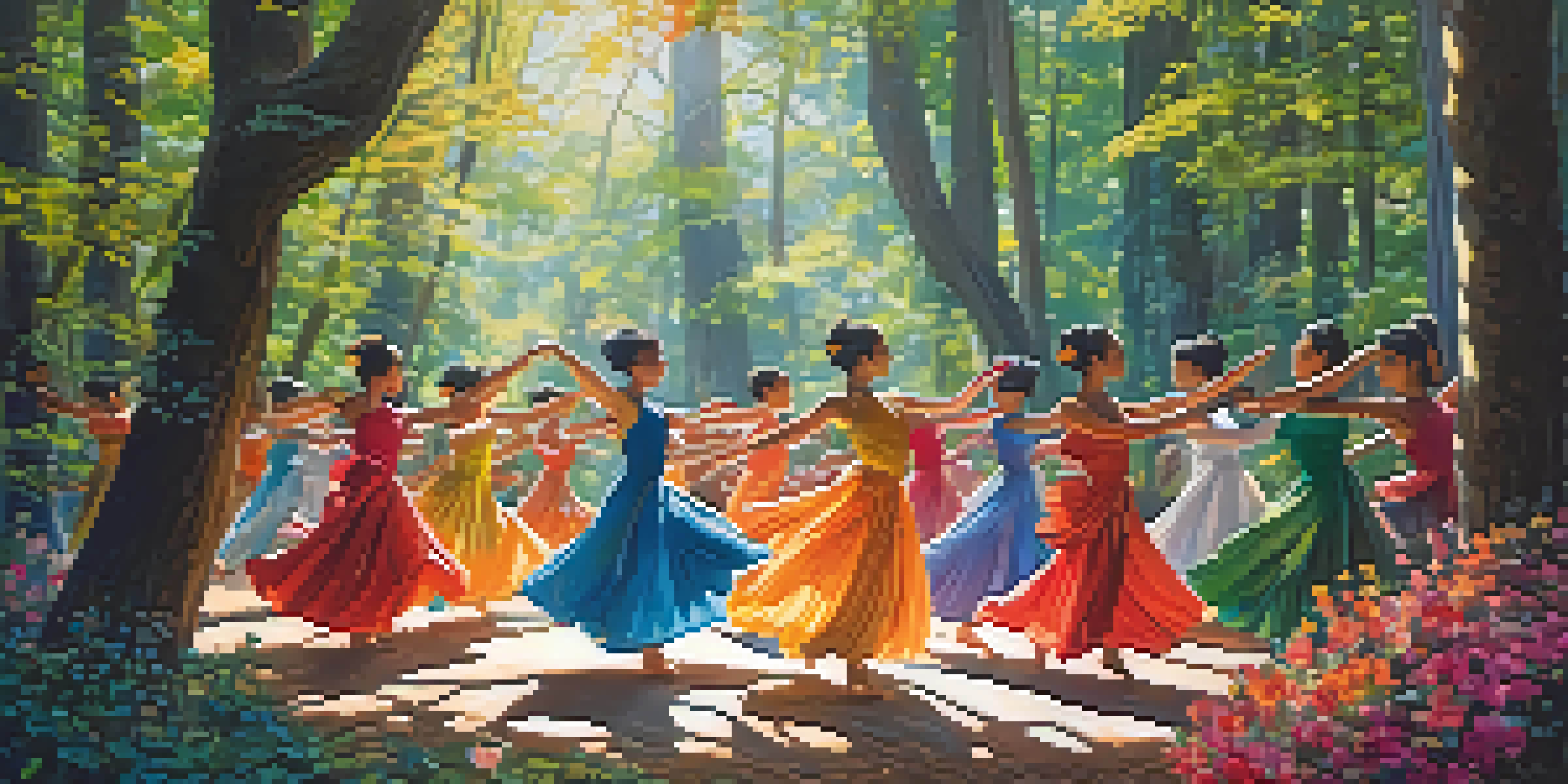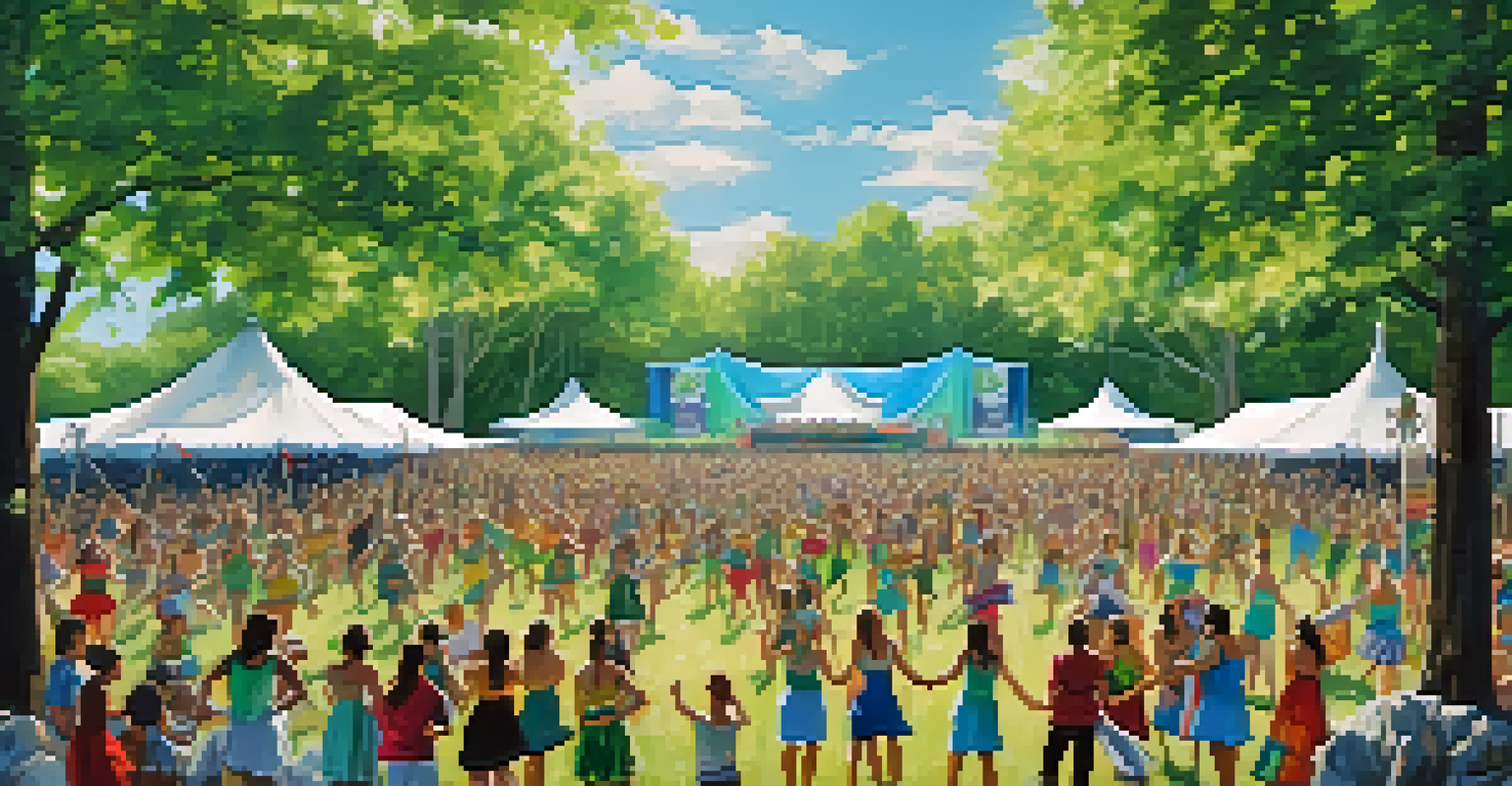Choreographing a Greener Future: Dance and Sustainability

The Intersection of Dance and Environmental Awareness
Dance has long been a powerful medium for expression, but its role in promoting sustainability is gaining traction. By intertwining choreography with environmental themes, dancers can raise awareness about climate change and ecological issues. Through performances that highlight the beauty of nature, artists inspire audiences to reflect on their own environmental impact and responsibilities.
Dance is the hidden language of the soul.
For instance, a dance piece that mimics the flow of a river can evoke feelings of respect for natural water sources. Audiences may leave with a deeper appreciation for the environment, recognizing the fragility of ecosystems. This emotional connection can be a catalyst for change, encouraging individuals to take active steps towards sustainability.
Moreover, the dance community is increasingly collaborating with environmental organizations to spread awareness. By utilizing their platforms, artists can reach broader audiences and spark conversations about the urgent need for ecological stewardship.
Sustainable Practices in Dance Productions
Just like any other art form, dance productions can adopt sustainable practices to minimize their ecological footprint. This can include using energy-efficient lighting, sourcing costumes from sustainable materials, and reducing waste during performances. By making conscious choices, dance companies can lead by example and inspire other industries to follow suit.

For instance, some organizations have begun using recycled materials for set designs, transforming plastic waste into stunning visual backdrops. These innovative solutions not only reduce waste but also serve as powerful visual statements about sustainability. Audiences are often surprised and inspired by the creativity that emerges from these constraints.
Dance as a Voice for Nature
Through performances that reflect environmental themes, dance can inspire audiences to connect with and take action for the planet.
In addition, many dance companies are exploring virtual performances, which can significantly reduce the carbon footprint associated with travel and large venues. This shift not only embraces technology but also opens up dance to a wider audience, breaking down geographical barriers.
Choreography Inspired by Nature
Nature serves as an endless source of inspiration for choreographers. Whether it’s the movement of animals, the rustling of leaves, or the ebb and flow of tides, the natural world offers a rich tapestry of ideas. By drawing from these elements, dancers can create pieces that not only entertain but also educate about environmental issues.
We do not inherit the earth from our ancestors, we borrow it from our children.
For example, a piece inspired by the migration of birds can illustrate the challenges these animals face due to climate change. This connection between dance and the environment can instill a sense of urgency in audiences, prompting them to consider their role in preserving these natural wonders. As viewers witness the beauty of nature through movement, they may feel compelled to take action.
Additionally, incorporating natural sounds and visuals into performances can enhance this connection. The harmony of a dance piece combined with the sounds of chirping birds or flowing water creates an immersive experience that can leave a lasting impression.
Dance Festivals Emphasizing Sustainability
Dance festivals are becoming increasingly aware of their environmental impact and are taking steps to promote sustainability. Many festivals are implementing eco-friendly practices, such as offering biodegradable materials and encouraging public transportation use. These initiatives not only reduce waste but also create a culture of sustainability within the dance community.
For instance, some festivals now feature workshops that educate dancers on sustainable practices, from costume design to environmental advocacy. This kind of education helps to instill a sense of responsibility in future generations of performers. By integrating sustainability into the fabric of these events, festivals can inspire attendees to adopt greener habits.
Sustainable Practices in Dance
Dance productions are adopting eco-friendly practices, such as using recycled materials and virtual performances, to minimize their environmental impact.
Moreover, showcasing works that address environmental themes can amplify the message of sustainability. When audiences see these performances, they are more likely to engage in conversations about ecological issues and consider their impact on the planet.
Community Engagement Through Dance and Sustainability
Community engagement is a critical component of promoting sustainability through dance. By collaborating with local organizations and schools, dance companies can create programs that educate and empower individuals to take action for the environment. These initiatives often foster a sense of community and shared purpose.
For example, a community dance project might involve participants in creating choreography that reflects their relationship with the local environment. This not only gives them a voice but also encourages them to think critically about their surroundings. As they engage in the creative process, they become more aware of environmental issues affecting their community.
Additionally, these programs can culminate in performances that showcase the participants' work, further raising awareness. When local audiences witness their neighbors expressing important environmental messages through dance, it can create a ripple effect of inspiration and action.
The Role of Technology in Sustainable Dance
Technology is transforming the dance world, offering new avenues for sustainability. From live-streaming performances to using social media for outreach, technology can significantly reduce the carbon footprint associated with traditional dance practices. This shift allows artists to reach a global audience without the environmental costs of travel.
For instance, many dance companies have embraced virtual reality (VR) and augmented reality (AR) to create immersive dance experiences. These technologies not only engage audiences in innovative ways but also allow for eco-friendly storytelling. By showcasing environmental themes through these platforms, choreographers can spark conversations about sustainability on a broader scale.
Community Engagement in Sustainability
Collaborative dance projects empower communities to express their environmental concerns, fostering awareness and action through creative engagement.
Furthermore, using data analytics can help dance companies track their sustainability efforts, from energy consumption to audience engagement. This insight allows organizations to make informed decisions that enhance their ecological initiatives, ensuring that they continue to improve over time.
The Future of Dance and Sustainability
As awareness of environmental issues grows, the future of dance is likely to become even more intertwined with sustainability. Artists will continue to explore ways to express ecological themes through their work while adopting practices that minimize their impact on the planet. This evolution is essential for the survival of both the art form and the environment.
In the coming years, we can expect to see more collaborations between dancers and environmentalists, resulting in projects that push boundaries and challenge societal norms. As these partnerships flourish, they will inspire a new generation of artists committed to making a difference. Dance can serve as a powerful tool for change, encouraging individuals to reflect on their relationship with the planet.

Ultimately, the choreography of a greener future lies in the hands of artists willing to embrace sustainability. By continuing to innovate and engage with their communities, dancers can lead the way toward a more harmonious relationship with nature.